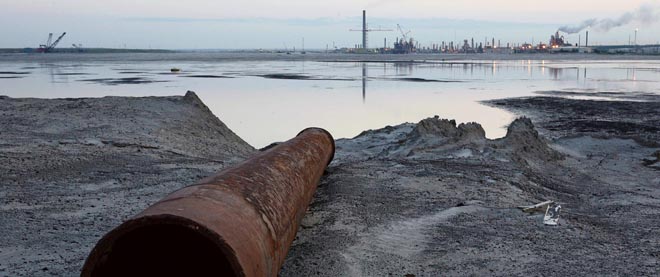Several provinces are falling behind on their fiscal targets this year as lower energy prices and a lower Canadian dollar shake up the country’s regional economic landscape.
Billions of dollars are disappearing from the Alberta economy because of dropping oil, and suddenly Ontario is poised to lead the nation in economic growth even though it faces serious fiscal pressures.
It is, as TD Economics calls it, a changing of the guard. Some provinces are bracing for a slowdown, while others expect a sudden jolt of good news.
A review of fiscal updates across the country shows just three provinces have revised their bottom line projections this year to show an improvement, notably British Columbia, which is now forecasting a $444-million surplus after projecting a $184-million surplus earlier this year. Three have made downward revisions, including Manitoba, which revised its projected deficit to $402-million from $357-million earlier this year. Four are unchanged.
Newfoundland and Labrador – another energy producing province – has also said its expects a $916-million deficit rather than a $538-million deficit. Saskatchewan, which collects royalties, has said its finances are unchanged, but that it will take a hit next year if the price of oil stays low.
Alberta is still officially expecting a surplus this year, though a smaller one than previously forecast. That estimate could change again as Premier Jim Prentice has said he expects low oil prices will deliver a $7-billion hit to provincial revenue.
A summary of updated provincial forecasts was compiled by TD Economics. The Globe compared the figures with a similar report from June 4 to show provincial trends. The timing essentially captures how government budget forecasts released in early 2014 compare with recent fall fiscal updates.
The price of North American crude has dropped by nearly half since July, closing on Monday at $55.26 (U.S.) a barrel. Prices dropped Monday after Saudi Arabia’s oil minister mused that the country could accept a price as low as $20. During the second half of 2014, the Canadian dollar has declined from around 93 cents (U.S.) to 85.93 cents on Monday.
At $12.5-billion, Ontario’s deficit forecast is unchanged. However, that amount is the biggest deficit of all of the provinces by far and bond-rating agencies are urging the province to come up with a clear plan for delivering on a promised balanced budget by 2017-18.
Projections for improved bottom lines were made by British Columbia, New Brunswick and Nova Scotia.
The developments will have a direct and painful impact on government revenue in energy-producing provinces such as Alberta, Saskatchewan and Newfoundland and Labrador, while also forcing Ottawa to adjust its plans for the 2015 pre-election budget.
Reports released last week by CIBC World Markets and TD Economics both predict significant change as to the sources of growth in the Canadian economy. Both reports said Ontario will lead the country in growth in 2015 and 2016, while Quebec will also gain from the new landscape. The Alberta economy, which had been well-ahead of the pack for growth, will slip back to around the national average.
The slide in the value of the Canadian dollar, combined with a strengthening economy in the United States, has central-Canadian manufacturers eager to ring in the New Year.
“2015 could easily surpass previous high-water marks,” said Don Berggren, president of Toronto-based Berg Chilling Systems Inc., which manufactures industrial heating and cooling systems for clients across the country and internationally.
The combination of the 2008-09 financial crisis and a Canadian dollar near parity led to years of pain for manufacturers, but recent developments are prompting new optimism.
“I’m hoping to see changes around the corner,” said Mark Zimny, president of Oakville-based Promation Engineering Ltd., which manufactures robotics systems primarily for the automotive and nuclear sectors.
The high dollar forced Mr. Zimny to pull out of the U.S. market years ago, but he’s planning to get back in next year because of expectations of a stronger auto market and the lower dollar.
“My quote will gain a few extra points easily by sheer lower dollar value,” he said. “Automatically, by definition, you’re getting a competitive edge.”
Even before the drop in oil, provinces were facing long-term financial stress. Parliamentary Budget Officer Jean-Denis Fréchette repeated his warning this fall that while federal finances are sustainable, provinces will need to cut spending or hike taxes to meet the looming cost pressures of changing demographics.
A boost in growth will be welcome news in Ontario, but economists say it will merely give the province a little bit of breathing room. Bond-rating agencies are concerned about Ontario’s high debt and are pressing the province to produce details as to how it will achieve plans to return to balance by 2017-18.
Andrew Leach, the Enbridge professor of energy policy at the University of Alberta, said the Alberta government will clearly take a major hit in terms of billions in lost oil royalties, but the immediate impact on the broader provincial economy will likely be more muted.
“These are long-lived projects. They’re not something where somebody’s going to down tools at an oil sands plant at $50 crude,” he said.
“If your disaster scenario is 2 to 3-per-cent growth, I don’t know that that’s disastrous. It’s just not what we were used to in Alberta.”





















Laissez un commentaire Votre adresse courriel ne sera pas publiée.
Veuillez vous connecter afin de laisser un commentaire.
Aucun commentaire trouvé